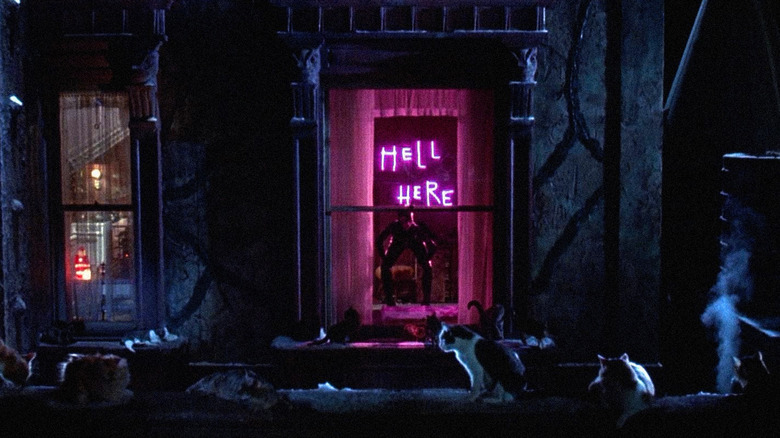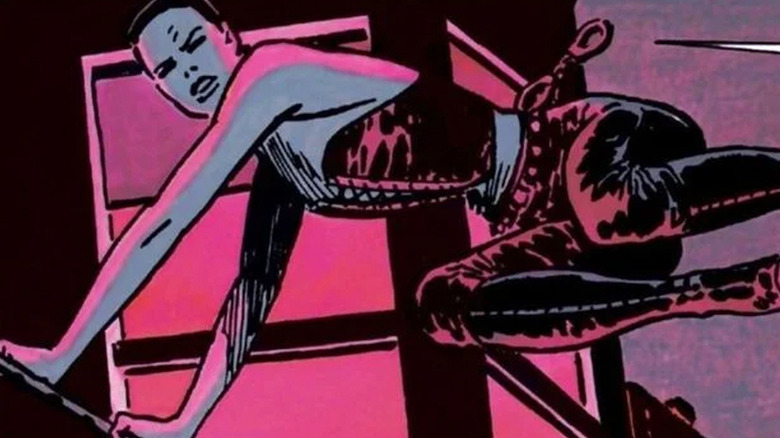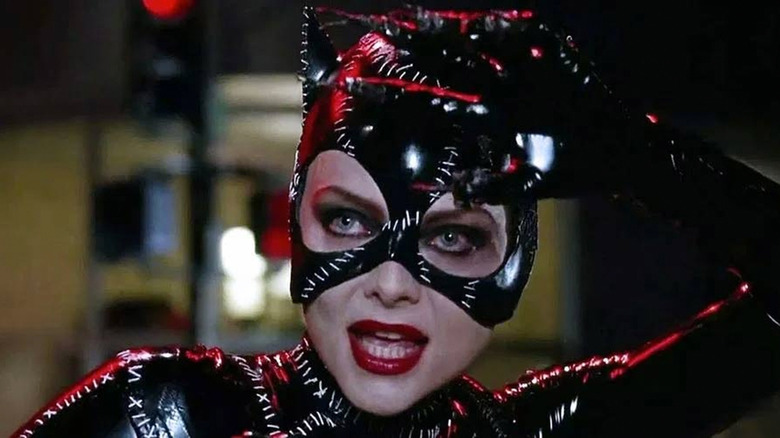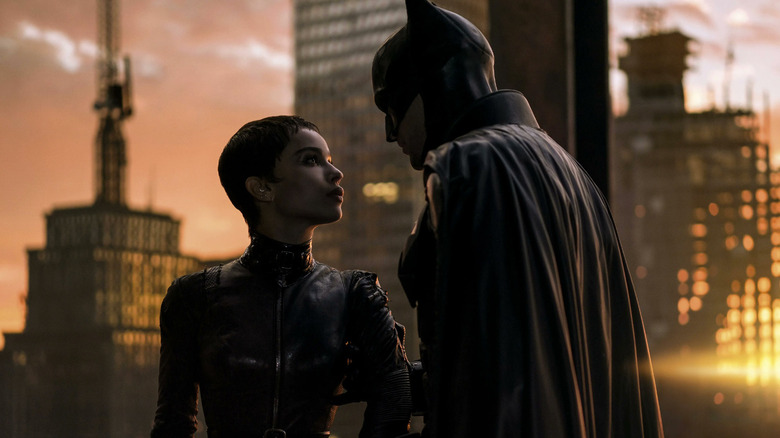So Much Yummier: The Fabulous Legacy Of Selina Kyle
It makes sense that a character who's been around for more than 80 years should be reincarnated every once in a while, and in "The Batman," Selina Kyle has made perfect use of her nine (and counting) lives. Since debuting in 1940 in Bill Finger and Bob Kane's "Batman #1," Catwoman has been many things: first the jewel thief known only as "The Cat," then eventually Selina Kyle, and even at one point — to everyone's dismay — one Patience Phillips. Her chameleonic evolution has spanned decades, and no two versions of the Catwoman are identical. Like Selina's perpetually-shifting allegiances, the character herself is difficult to define — but maybe that's exactly why we love her so much.
No matter her name or her origin, Catwoman has always been a paladin for female desire. Like her namesake, she goes where she pleases; like many "unpredictable" women, she does what she likes — and doesn't care who gets in the way. In Batman's early days, her duplicitous nature made it easier to label her as a villain — though even in those days, she served as the Bat's main love interest — and only by introducing a convenient amnesiac storyline could Selina's past wrongs be righted.
It was the first of many retcons, one that would itself be remixed 40 years later in "The Brave and the Bold." In this storyline, Selina revealed that her amnesia was actually a lie, and that she turned to crime in an effort to escape an abusive man. This too would be retconned within a few years (sensing a pattern here?), but the men of Selina's past would continue to define her origins. Sometimes successfully, sometimes less so.
Crossing the feline
In Batman's "Modern Era," Frank Miller and David Mazzucchelli reimagined Selina Kyle as a leather-clad sex worker. This origin became one of her most controversial backstories — mostly because now, Miller is known more for his misogyny (among many, many other things). By contrast, Selina has since become something of a defender of marginalized women. Even if she's not always explicitly a sex worker herself, a good number of her storylines — like Ed Brubaker's celebrated comic run from the early 2000s — see her protecting women from the brutality of the men around them.
Though the storylines following "Year One" often fail to build on their shallow depiction of sex work (and most fans don't really like it anyway), The Modern Era was still instrumental in crystalizing Selina's core ethos. On paper, Selina and her feline alter ego are easy to be reduced to their reclaimed sexuality — which, more often than not, looks a lot like fetishization. But so many fail to see that it's not merely sexuality Selina has reclaimed, but power. It's not just that she's confident: she's pretty much abandoned the concept of fear.
That's not to say that Selina is never afraid. Some of her best storylines challenge the self-assured persona she's spent so many years perfecting, and take her out of her well-worn element. But there is a kind of fear — maybe, more accurately, an uncertainty — that women are trained to feel from an early age. Society is obsessed with the idea of "humbling" women, which makes a threat out of anything to the contrary.
Selina Kyle flies in the face of all this, and her characterization is often its best when embracing the kind of threat this suggests. It's what made Michelle Pfeiffer's take on Catwoman the most definitive and recognizable: she is sexy for sure (it's Michelle Pfeiffer in a latex catsuit, for crying out loud) but also ... terrifying. She is so much more than a campy take on a then-50-year-old anti-heroine. She's the embodiment of the very-real shift brought on during feminism's third wave.
The fallen (cat)woman
The '90s saw women gaining opportunities they'd never had access to before, joining the workplace in larger roles and pursuing educations rather than starting families. It was the dawn of a "gender-equal" society where women could have it all — at least, that was the story on paper. Even in the face of so much progress, women faced more vilification than ever before. The '90s also saw the dawn of the 24-hour news cycle, which picked apart any scandal that had a woman at its center. Sexual harassment in the workplace ran rampant, and its perpetrators rarely faced any consequences.
This was the world in which Pfeiffer's Catwoman was born. Throughout the years, Batman villains have been stand-ins for real-world controversies — think the Occupy Gotham moment in "The Dark Knight Rises" — but none have carried such nuance as the Catwoman of "Batman Returns." She embodied so much of what was happening at the time (some of which still is happening): sexual harassment, brutalization of lower-class women, and the patriarchal pressure to adopt "masculine" pursuits (like career and education) while still invoking sexual desire.
Pfeiffer's Selina represents the crux of these dueling expectations, and the schism they often create in women trying to juggle it all. "We're the same," Batman even tells Catwoman at one point, "split right down the center." He's of course referring to the toll of their alternate identities, but Selina was actually split long before she became Catwoman. When we first meet Selina, she is a mousy secretary who's long been conditioned into "humility" — but on her it looks much more like self-loathing. She understands what she's supposed to be, but the hypocrisy of it all leaves her fractured. It takes an attempted murder at the hands of her megalomaniacal boss to bring her clarity. Becoming Catwoman makes her whole. It makes her frightening. And it's made Pfeiffer's interpretation of the character one of the most empowering even now, 30 years later.
Hear her roar
At the risk of getting soapbox-y, this is what Catwoman at her best represents. It's what makes her character so good, even — in the case of Halle Berry's much-maligned take on the character — when she's done wrong.
For the record, it is hard to find the merits in Jean-Christophe "Pitof" Comar's CGI-laden "Catwoman." To say Berry deserved better (especially knowing she took the role to pave the way for more Black action heroes) is the grossest of understatements. "Catwoman" may be very bad, but seeing a black woman don the signature mask for the first time since 1966 was equally empowering for the women of color who came of age in the early 2000s, this writer included. Berry's efforts deserve to be honored — and maybe even redeemed down the line? — but at least for now, the mantle rests with Zoë Kravitz ... and no one in their right mind should be complaining about that.
Kravitz's Catwoman is obviously one of the most grounded iterations of the character; there's not a lot of room for camp in Matt Reeves' rain-drenched Gotham. But the Selina Kyle of "The Batman" still manages to synthesize the best of each Catwoman that came before, both from the page and the screen. She also brings some much-needed heart and empathy to the film, especially juxtaposed with Robert Pattinson's steely dark knight.
Selina has always been a foil to Batman and Bruce Wayne, the feminine counterpart to his very masculine rage. But Kravitz accentuates this contrast as a woman of color, taking the baton from Anne Hathaway's Catwoman to challenge Bruce's inherent privilege. Though "The Batman" fails to fully commit to Selina's bisexuality (or her contested background in sex work), her portrayal in the film still understands her importance to the world of Gotham — and our world, too. She is still a woman who shirks societal expectations to pursue her own pleasure, and fights for others who can't make that choice so easily. She puts herself first, and sometimes that makes her a villain — but when villainy looks that good, it's hard to root for anything (or any one) opposing it.



